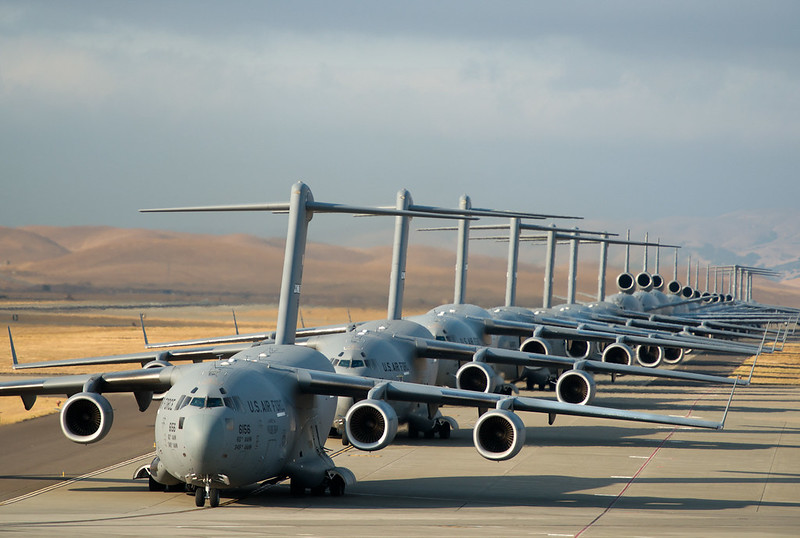
A 22-aircraft “freedom launch” took place Sept. 11, 2013, at Travis Air Force Base, Calif. Seven C-17 Globemaster IIIs, 11 KC-10 Extenders and four C-5B Galaxies from the 60th Air Mobility Wing lined up in what is historically referred to as an “elephant walk,” then launched consecutively over 36 minutes to take part in Air Mobility Command missions. (U.S. Air Force photo by Ken Wright/Released)
The military’s massive cargo planes are getting old and need replacement. Doug Cameron discusses what’s next for the military’s cargo plane acquisitions program. He writes in The Wall Street Journal:
Sometimes, you need a really big plane.
An Air Force C-17 Globemaster evacuated 640 passengers in a single flight from Kabul during the U.S. withdrawal two years ago. The C-5M Super Galaxy, even bigger than the Globemaster, can carry anything in the Army’s arsenal—or the presidential motorcade and helicopter.
The mammoth jets, however, are aging and out of production. That has pushed the Pentagon to start looking at replacements capable of flying vast distances in support of U.S. forces in the Pacific as part of its policy to deter China. More broadly, the Air Force envisages a family of systems including a large new aircraft, small uncrewed delivery drones, gliders, and even space rockets to blast cargo anywhere in the world within minutes.
Air Force leaders are still sketching out requirements for the next generation of airlift planes. They are trying out ideas in an exercise this month across the Pacific called Mobility Guardian 2023 involving 70 cargo and refueling aircraft and 3,000 airmen and troops.
‘We’ll really test ourselves on how quickly we can move,” Air Force Chief of Staff Gen. Charles Q. Brown Jr. said last week during a confirmation hearing to become the next chairman of the Joint Chiefs of Staff.
For now, the jumbo jet-sized C-5, which entered service in 1970 and the C-17, which joined the fleet in 1993, form the backbone of the transport fleet. Boeing ended C-17 production in 2015, and the Air Force operates around 220 of them. Lockheed Martin stopped making the C-5 in 2002, and 52 remain in the fleet.
“Those planes aren’t getting any younger because the C-17 was brand spankin’ new when I started flying in 1996,” said Darren McDew, a retired general who led the U.S. Transportation Command.
The C-5 has doors at the front and the back to enable troops and supplies to be loaded and unloaded at the same time from cavernous cargo bays. Like the C-17, it has high wings and four powerful engines allowing them to operate from even small, unpaved runways.
Read more here.
If you’re willing to fight for Main Street America, click here to sign up for the Richardcyoung.com free weekly email.





